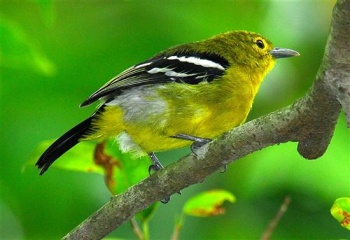Alternative names: Indian Iora, Black-winged Iora, Small Iora, Ceylon Iora (multicolor)
- Aegithina tiphia
Identification
12.5 - 13.5cm. A small, chunky bird.
Male
- Black wing and tail
- Large white wing-bar
- Bright yellow underparts
- Pale eyes
- Mantle green (tiphia) to black (multicolor, humei)
- Non-breeding male like females
Female
- Dull olive green upperparts
- Duller yellow underparts
Immatures are greener below
Similar Species
From Green Iora by bright yellow to yellowish underparts.
From Marshall's Iora by lack of pale tips on tail and narrower white edges on blackish tertial centres.
Distribution
India, southern China and Myanmar through South-East Asia to the Greater Sundas, Bali and Palawan (Philippines).
Common in most of its range.
Taxonomy
Sometimes considered conspecific with Marshall's Iora.
Subspecies
There are 11 subspecies[1]:
- A. t. multicolor: Southern India and Sri Lanka
- A. t. deignani: Peninsular India to northern and central Burma
- A. t. humei: Central India (south of the Ganges River)
- A. t. tiphia: North-eastern India (Kumaon to Bengal and Assam)
- A. t. septentrionalis: Pakistan and north-western India (Punjab)
- A. t. philipi: South-western China to central Burma, northern Thailand, Laos and northern Vietnam
- A. t. cambodiana: Cambodia to south-eastern Thailand and southern Vietnam
- A. t. horizoptera: Southern Burma to Thailand, Malaysia, Sumatra and adjacent islands
- A. t. scapularis: Java and Bali
- A. t. viridis: Southern Borneo
- A. t. aequanimis: Northern Borneo, adjacent northern islands and Palawan
Four additional subspecies, trudiae, micromelaena, djungkulanensis and singapurensis are generally considered invalid[4]
Habitat
Mangroves, open country, scrubs, forested river banks, plantations and gardens.
Usually found in the lowlands. Up to 2000m in the Himalayas.
Behaviour
Frequents the tree tops usually in pairs.
Diet
Gleans insects from the foliage and branches.
Breeding
Breeding season from December to September in India. The nest is placed 1-10m above the ground in a fork or directly on the bark surface. Lays 2-3 eggs.
Brood parasitism by Banded Bay Cuckoo common.
References
- Clements, J. F., T. S. Schulenberg, M. J. Iliff, S. M. Billerman, T. A. Fredericks, B. L. Sullivan, and C. L. Wood. 2019. The eBird/Clements Checklist of Birds of the World: v2019. Downloaded from http://www.birds.cornell.edu/clementschecklist/download/
- Del Hoyo, J, A Elliot, and D Christie, eds. 2005. Handbook of the Birds of the World. Volume 10: Cuckoo-Shrikes to Thrushes. Barcelona: Lynx Edicions. ISBN 978-8487334726
- Rasmussen, PC and JC Anderton. 2005. Birds of South Asia: The Ripley Guide. Barcelona: Lynx Edicions. ISBN 978-8487334672
- Avibase
Recommended Citation
- BirdForum Opus contributors. (2024) Common Iora. In: BirdForum, the forum for wild birds and birding. Retrieved 28 April 2024 from https://www.birdforum.net/opus/Common_Iora
External Links
Search the Gallery using the scientific name:
Search the Gallery using the common name:
GSearch checked for 2020 platform.








